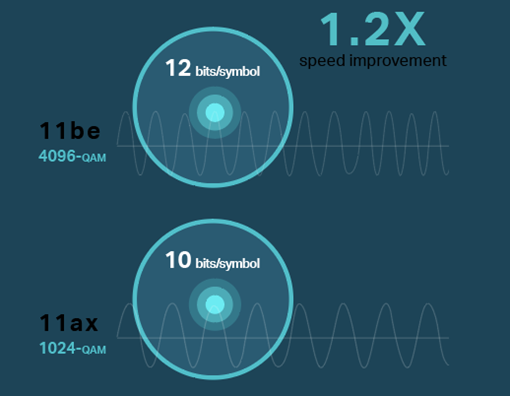What is WiFi 7? An in-depth overview of the future WiFi
Innovations to wireless internet access don’t seem to be slowing down anytime soon. After all, to keep up with the times, WiFi must also evolve to improve speed, reduce latency, and increase network capacity. This way, private and public access can meet the rapid growth of wireless devices and emerging applications.
The latest standard, WiFi 6, was introduced not too long ago. But now, WiFi 7 is already on the horizon. As the next stage of WiFi, what new features will WiFi 7 deliver? Why will we need WiFi 7? And when will it be available?
Here, we'll give an in-depth overview.
What is WiFi 7? What is IEEE 802.11be?
WiFi 7 is the upcoming WiFi standard, also known as IEEE 802.11be Extremely High Throughput (EHT). It utilizes the 2.4 GHz, 5 GHz, and 6 GHz frequency bands. Building off WiFi 6, WiFi 7 introduces 320 MHz ultra-wide bandwidth, 4096-QAM, Multi-RU, and Multi-Link operation.
Why we need WiFi 7?
Although WiFi 6 realized a 37% nominal rate increase, it was not as concrete as the 10-fold rate increase that WiFi 5 brought. The difference stemmed from the original intention of the WiFi 6 project, which aimed to improve efficiency rather than data rates. Meaning, WiFi 6 could offer better experiences in high-density environments, but its "negligible growth" in speed was not attractive.
Emerging applications (like 4K/8K videos involving transmission rates of up to 20 Gbps, VR/AR, remote offices, and cloud computing) require extremely high throughput and ultra-low latency, far beyond the capabilities of IEEE 802.11ax (WiFi 6). To meet these future demands, IEEE will release a new amendment standard IEEE 802.11be (WiFi 7).
What technical innovations will WiFi 7 deliver?
The 11be project aimed to realize goals related to higher nominal data rates, higher spectral efficiency, better interference mitigation, and RTA support. To achieve these goals, the 802.11 working group discussed approximately 500 proposals from different fields that can be mapped to the following seven directions of WiFi 7: EHT PHY, EDCA with 802 TSN Features, Enhanced OFDMA, Multi-Link Operation, Channel Sounding Optimization, Advanced PHY Techniques, and Multi-AP Cooperation. After further evaluation and verification, these technical directions were grouped into the physical layer (PHY) innovation and medium access control (MAC) innovation.
- Up to 320 MHz of Flexible Bandwidth
WiFi 6 expanded the WiFi band from 80 MHz to 160 MHz, effectively doubling the number of channels. WiFi 7 takes it a step further by doubling the bandwidth of WiFi 6, extending everything to 320 MHz.
WiFi 7 adds new bandwidth modes including contiguous 240 MHz, noncontiguous 160+80 MHz, contiguous 320 MHz, and noncontiguous 160+160 MHz. This means more flexibility with channel allocations for less congestion.

- 16 Spatial Streams MU-MIMO
To meet the growing traffic demands generated by the increasing number of WiFi devices, APs have continued to increase the number of antennas and improve spatial multiplexing capabilities.
WiFi 6 supports 8 spatial streams working simultaneously, while WiFi 7 increases the number of spatial streams from 8 to 16. The theoretical physical transmission rate is thus doubled compared with WiFi 6.

- 4K-QAM
To further enhance peak rates, WiFi 7 adopts a higher-order modulation scheme: 4096-QAM. This enables each symbol to carry 12 bits rather than 10 bits, which means 20% higher theoretical transmission rates than WiFi 6’s 1024-QAM.
A higher transmission rate allows users to obtain higher transmission efficiency. Now you can watch flawless 4K/8K videos, play massive online games without lag, or live stream from your home computer. With 4096-QAM, streaming just got that much better.

- Multi-RU & Preamble Puncturing
With WiFi 6, each user can only send or receive frames on an assigned resource unit (RU), which significantly limits the flexibility of the spectrum resource scheduling. To solve this problem and further enhance spectral efficiency, WiFi 7 allows multiple RUs to be assigned to a single user and allows combining RUs* for increased transmission efficiency.
*To achieve the trade-off between combination complexity and spectral efficiency, small-size RUs (less than 242 tones) can only be combined with small-size RUs, whereas large-size RUs (more than or equal to 242 tones) can only be combined with large-size RUs. Mixing small-size RUs and large-size RUs is not allowed.

Assuming that an AP is transmitting data on a second 80 MHz band, if channel 56 is busy, then that band cannot be fully used. Data would only be sent through the primary channel. With Preamble Puncturing technology, the interference would be blocked, and the three other 20 MHz channels can be used to improve channel utilization.
- Multi-Link Operation
Multi-Link Operation (MLO) enables devices to simultaneously send and receive data across different frequency bands and channels. This is designed to increase throughput, reduce latency, and improve reliability for emerging applications like VR/AR, online gaming, remote office, and cloud computing.
Traditional WiFi devices use a single link to transmit data between the STA and AP. Introducing MLO, WiFi 7 supports establishing multiple links between the STA and AP for traffic balancing and better path selection.

When will WiFi 7 be released, and when will WiFi 7 routers be available?
In May 2021, IEEE released the draft 1.0 standard of WiFi 7 and is expected to release the draft 2.0 standard in March 2022. Similar to previous WiFi standards, the chip vendors will warm up the market in advance and develop chips based on the draft version. At present, some vendors have begun to promote WiFi 7 solutions. Commercial WiFi 7 products will most likely arrive on the market in 2023.
WiFi 7 vs WiFi 6, What’s the main difference?
|
WiFi 6 |
WiFi 6E |
WiFi 7 |
|
|
Launch date |
2019 |
2021 |
2024 (expected) |
|
IEEE standard |
802.11ax |
802.11be |
|
|
Max data rate |
9.6 Gbps |
46 Gbps |
|
|
Bands |
2.4 GHz, 5 GHz |
6 GHz |
2.4 GHz, 5 GHz, 6 Hz |
|
Channel size |
20, 40, 80 80+80, 160 MHz |
Up to 320 MHz |
|
|
Modulation |
1024-QAM |
4096-QAM |
|
|
MIMO |
8×8 UL/DL MU-MIMO |
16×16 UL/DL MU-MIMO |
|
What are the benefits of WiFi 7?
As a cutting-edge tech, WiFi 7 brings the following key benefits:
- Higher data rates, up to 46 Gbps
- Lower latency
- Increased transmission efficiency
- Larger network capacity for more devices
- More reliable performance in crowded networks
What will WiFi 7 contribute?
With extremely high throughput, lower latency, and reliable network performance, WiFi 7 will contribute to the development of emerging applications, such as:
- 4K/8K videos (involving data rates up to 20 Gbps)
- Immersive virtual reality (VR), augmented reality (AR), and extended reality (XR)
- Remote offices, real-time collaboration, online video conferencing
- Cloud/Edge Computing
- Cloud gaming
- Industrial IoT
- Metaverse
As the No. 1 provider of WiFi devices for 11 consecutive years, TP-Link has been keeping up with new technologies and developing new products to meet the demands of today and tomorrow.
Learn More about WiFi 7
How is WiFi 7 different from WiFi 6?
WiFi 7 Fundamentals: What is 4K-QAM?






